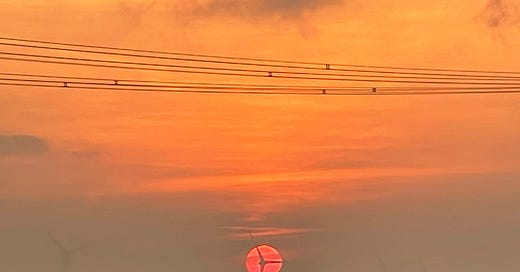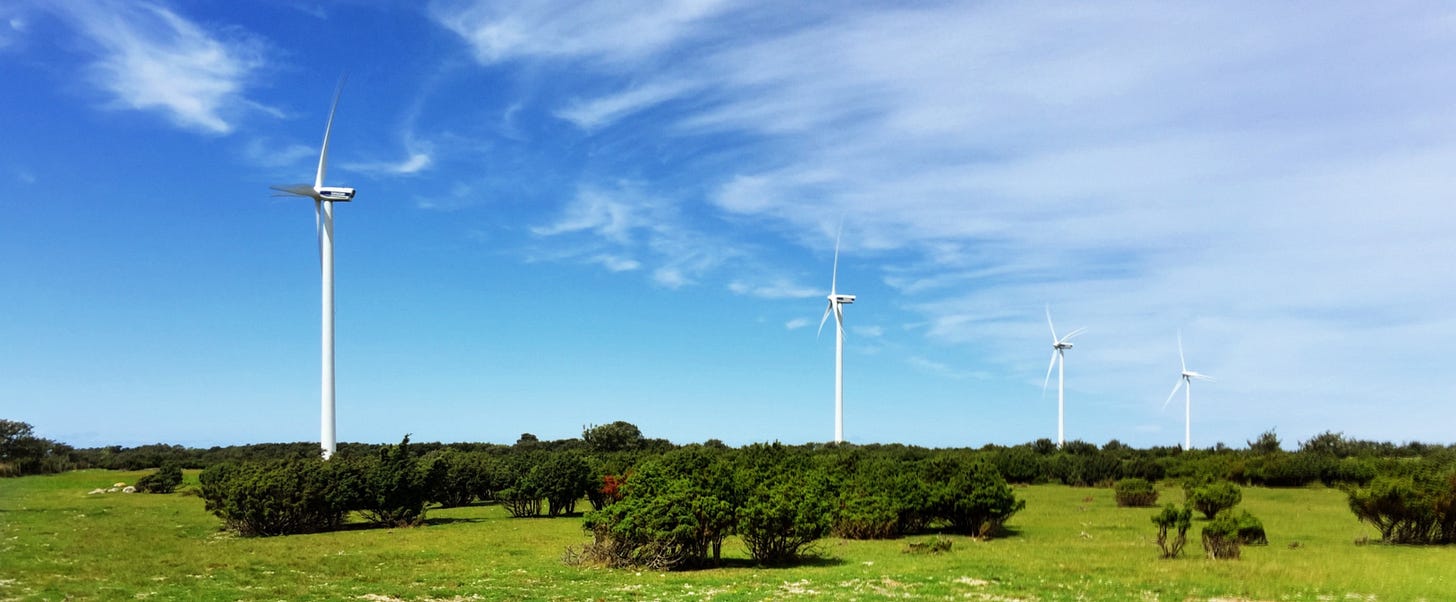Fun facts you would like to know about wind turbines
We have harnessed the wind for 4,000 years, and now we are rapidly scaling up capacity.
It is a new dawn for renewable energy sources like wind and solar, and in this picture, every element of that statement falls perfectly into place.
I took it yesterday during a beautiful sunrise while driving early in the morning from my village to Rotterdam. You can see one of the wind turbines in the eye of the rising sun. To the left, you can see one more grey turbine against the grey background in the early morning mist, and the photo captures the power lines in the sky.
Ancient Babylonians
The Netherlands has a reputation as a country of windmills to mill grain or pump water, and we still have some 1,100 of the classic types. I have shared in this newsletter quite a few pictures of the large white windmill of my village and others that I often see in the province of Zeeland. But the Dutch were not the first to harness the wind; the Ancient Babylonians likely did this already some 4,000 years ago.
By the end of the 19th century, following the invention of the electric generator in the 1830s, engineers in Scotland, Denmark, and the United States invented the first wind turbines to generate electricity. At the end of the 19th century, modern wind power was first developed in Denmark, where the first horizontal-axis wind turbines were created in 1891, and a 22.8-meter wind turbine began operation in 1897.
It took many technological improvements before engineers could build the first-megawatt-size wind turbine in Vermont in 1941. However, due to the wartime material shortages, a known weak point of the Smith-Putnam wind turbine could not be repaired, and a blade failed after 1100 hours of operation. Nevertheless, it remained the most powerful wind turbine until 1979.
Wind-turbine capacity has increased over time. In 1990, typical turbines in the Netherlands had a rated capacity of 0.155 megawatts (MW). By 2014 this had grown to 1,33 MW, and since then, the growth has continued. Today's new wind power projects have enormous capacities; for instance, this year's new Borssele III and IV projects in the province of Zeeland have turbines of 9,5 MW.
Size matters
Will there be an end to the growth in capacity? It doesn't look like it in the near future since Vestas unveiled a 15-megawatt wind turbine earlier this year. Each blade is 115.5 meters long (379 feet). The company plans to have a prototype up and running by next year.
Last year, during the final US presidential debate, Donald Trump claimed that using wind energy "kills all the birds." He was, again, wrong. The first bird you see flying when you look up from your screen proves that "all" is not correct in that statement; it is an example of why all experienced politicians always avoid worlds like all or always (and I am not a politician).
Earlier versions of wind farms had thousands of small fast-spinning turbines which killed quite a few birds. But modern wind turbines have taller and slower-moving blades that kill fewer birds.
For cat lovers - and bird lovers - the actual numbers are shocking: although wind turbines kill about 234,000 birds every year in the United States, felines kill 2.4 billion, according to the US Fish and Wildlife Service. So that makes cats about ten thousand times more deadly for birds than wind turbines.
I write this newsletter because I believe that together we can do better on this beautiful but fragile planet.
This newsletter is an independent production. Accordingly, I have never accepted any advertising offers. I also aim to make as many editions as possible available for free.
Support from those who can afford it makes this independent newsletter available to all. You can join this initiative by taking a paid subscription.
If the cost of this newsletter ($6/month, $60/year) would create any financial strain, please stay on the free list; I value all readers.
Notes:
https://www.visualcapitalist.com/animation-how-wind-turbines-work/
https://www.opusenergy.com/blog/13-little-known-facts-about-wind-energy/
https://www.nature.com/articles/ncomms2380?utm_medium=affiliate&utm_source=commission_junction&utm_campaign=3_nsn6445_deeplink_PID100024933&utm_content=deeplink#:~:text=We%20estimate%20that%20cats%20in,caused%20by%20un-owned%20cats.
https://www.irena.org/wind
https://nl.wikipedia.org/wiki/Windturbines_in_Nederland
https://www.bloomberg.com/news/articles/2021-07-09/world-s-biggest-wind-turbine-set-to-debut-in-germany-s-sea
https://www.energy.gov/eere/wind/articles/top-10-things-you-didnt-know-about-wind-power
https://www.businessinsider.com/cats-kill-more-birds-than-wind-turbines-despite-trumps-claims-2020-10?international=true&r=US&IR=T









Thank you Alexander,
Reading your letter made me think of the novel by author Henrik Pontoppidan 1898 and 1904, trained as an engineer who became an author (Now a movie, 2018) named 'Lucky Per' (Danish: Lykke-Per) or 'A Fortunate Man' in English. Lucky Per, an engineer on a mission to build a windmill to generate electric power for Denmark. It is his based on the personal life story of the author. I believe the film(a drama), setting is in Jutland, is beautiful, and worth seeing.
Living near the ocean wind is always noticeable. There has been much controversy about building wind farms off Long Island . Some are afraid the turbines will spoil their view or fishing but they finally will be built. The wind is indeed one of the best sources of clean energy. Thanks for a great article and may you have a happy weekend.